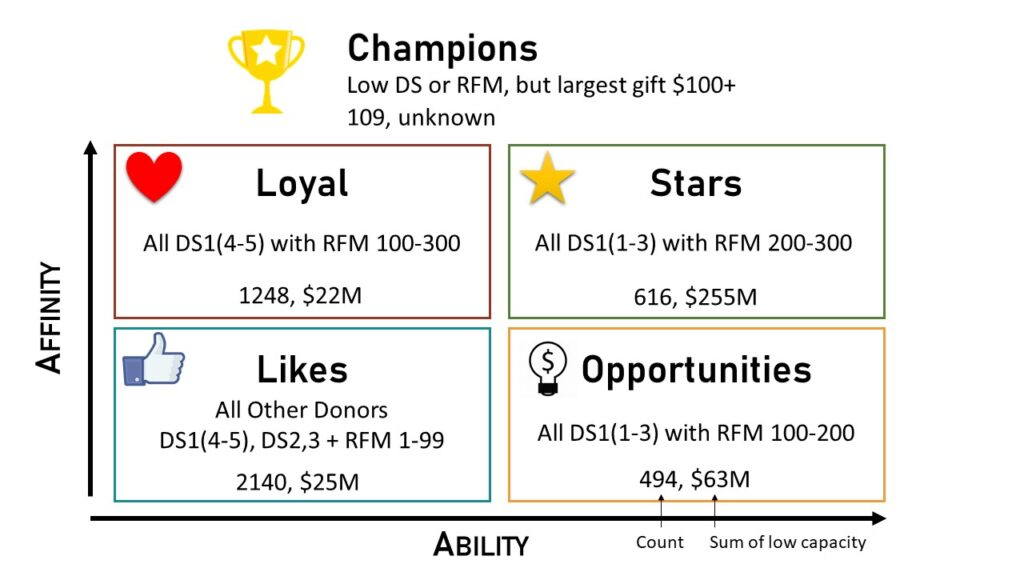You have a strong track-record leading teams. Your fundraising efforts have met or exceeded goal. So why are you struggling so much getting major gifts rolling in your new position? Maybe you have even thrown a good deal of money at the problem by purchasing some data enhancements or predictive scores and you still can’t quite get it to work.
You might even be wondering if other organizations have some kind of major gift fairy dust that they sprinkle over their database to sort out their prospect portfolios!
And maybe they do…
Secret Recipe for Major Gift Fairy Dust
The first step in prospect identification is to find a way to automatically filter or screen new donors as they arrive. Lots of organizations do this by talking to every donor who makes a gift at a certain threshold, such as $100+ or $1,000+. This is good, until it’s not good enough anymore.
Ingredients
The only way to assess your full data base of donors or new donors as they arrive is to define what makes a Best Prospect. To do this, you have to select the right ingredients.
When working with a pool of existing donors, I recommend these ingredients:
Affinity: Affinity is really the secret sauce in this recipe. What data points are a measure of the donor’s alignment or love or engagement with your organization? If you can add this to your recipe, you will do very well!
Ability: Knowing a measure of the wealth available to give, even with a pretty wide margin of error, is super helpful.
Inclination: Data is available to show whether someone has philanthropic interest. The donor may have given to other organizations and been publicly recognized for those gifts or s/he might serve on nonprofit boards or have a foundation. By definition, philanthropic individuals are much more likely to give than non-philanthropic individuals.
Once you understand what the ingredients are, you can now begin to identify those ingredients to create your own major gift fairy dust. There are many choices to make, such as the vendor offering an ingredient or various flavors of the same basic ingredient. I am sure you already have many software companies trying to sell their products to you!
Instructions
In any recipe you have ingredients and then you have instructions. The instructions tell you how to combine everything and turn it into major gift fairy dust. But not everyone succeeds at making a tasty dish or a high-performing major gift prospect list from a recipe. Sometimes it is because the ingredients weren’t of the highest quality and sometimes it is because the instructions assume a certain level of starting experience and knowledge.
For example, one of the best things to happen to me, a very reluctant cook, was Pinterest. I can find all kinds of recipes posted by bloggers and “pinned” to Pinterest. I have food allergies and these bloggers don’t just post ingredients and instructions, they write an entire blog post on how to choose and substitute ingredients, as well as all sorts of additional preparation tips–before they even get to the recipe. This has really taught me how to cook better food for my dietary needs!
When I write up the instructions for turning a combination of ingredients or data points into prioritized prospects, I call it segmentation. I prefer to “flatten” the ingredients into two numbers and present it via some kind of visual, such as the illustration below.

And much like the Pinterest blog post prior to the recipe, my experience has taught me how and when to modify the recipe ingredients and instructions to fit unique scenarios and organizations.
The Prospect Research Professional Chef
In addition to a recipe, baking and cooking takes experience. Identifying prospects and choosing data providers takes experience, too. Sure, anyone can do it, but the results most often reveal exactly how much experience when into it.
How to approach prospect identification is going to vary greatly because organizations are all very different. An organization with a 10-person major gift team is very different from a 100-strong major gift team that has a supporting prospect research department, and both of those are very different from a development officer in charge of a 5-person development team that does everything.
If you decide to embark on a prospect identification project and are not going to hire an experienced professional, you can still use the three ingredients to assess your internal data as well as what external vendors are offering you.
You can ask informed questions, such as the following:
- Do we have affinity markers immediately available from our INTERNAL data (giving data especially!) or can we easily build or buy an affinity marker based on our own data?
- If the vendor is offering EXTERNAL data for affinity, how well does it align with our organization? For example, is affinity for youth causes too broad to be useful to your early intervention programs for pre-school children? Can you have a custom affinity model built?
- Is the data being offered a predictive model (e.g., likelihood to make a major gift) or a data enhancement or append (e.g., largest gift found to others)?
- Exactly what does the ability marker mean? Is it estimated net worth? Is it a gift capacity range over one year or five years?
- If you receive some kind of numerical score, will you be provided with definitions? Such as “80-100 is Very Good” and “60-79 is Good” etc.
- When you receive the data back from the vendor, how will you know which names are the be stand why? Will you be able to filter on a score or data point and relate it back to the database ID number/name of constituent?
Beyond the Recipe
Keep in mind that you can sprinkle all the fairy dust you want, but unless you have the skill to take action, nothing magical is going to happen. On the other hand, if you can recognize and leverage the three main ingredients in major gift fairy dust, and leverage affinity as your “secret sauce,” you will be well on your way.
I know it sounds too simple, and “major gift fairy dust” is a silly way to refer to a best practice, but I’ve seen too many talented development leaders purchase very expensive data only to flounder. There will always be hype around the next and greatest innovation in fundraising, but the fundamentals of what builds strong relationships will stay the same.
If you can focus on the three main ingredients–Affinity (above all), Ability, and Inclination–you can begin to sift through and better understand all of the data purchasing choices that are put in front of you. Because even though data might not be your “thing,” you are a talented fundraiser and leader!
Additional Resources
- Segmentation and Personalization in Fundraising Appeals |John Killoran | Aspire Research Group Fundraising Insights | 2021 | This is a great example of how segmentation to nurture and grow your direct fundraising appeals differs from segmenting for major gifts.
- Can You Spot the HNWIs In Your Database? | Jennifer Filla | 2017
- Net Worth vs. Capacity: What’s The Difference and Why Should You Care? | Jennifer Filla | 2020
- Stupid Is as Stupid Does: On Using Gift Capacity Ratings | Jennifer Filla | 2022
